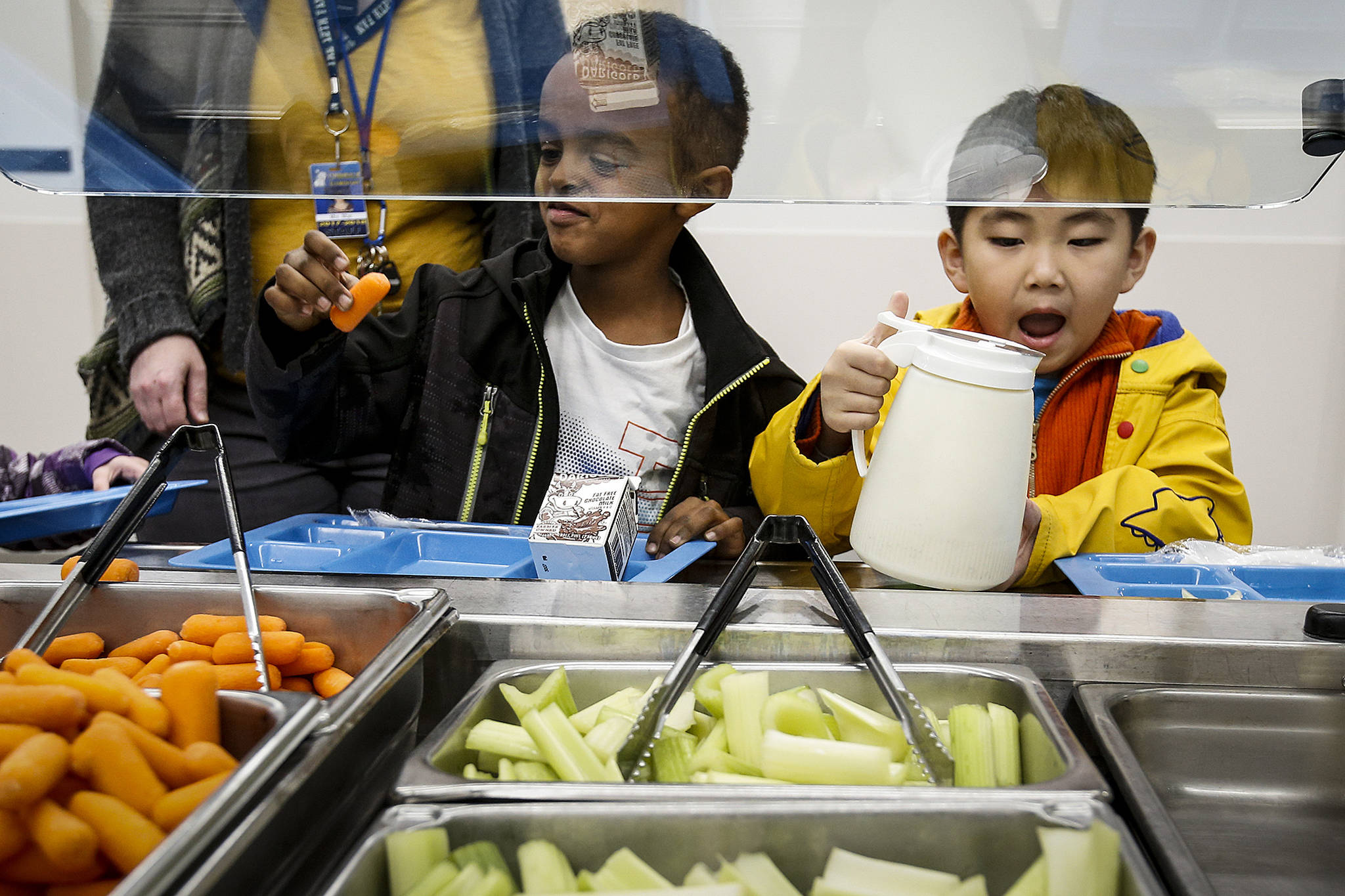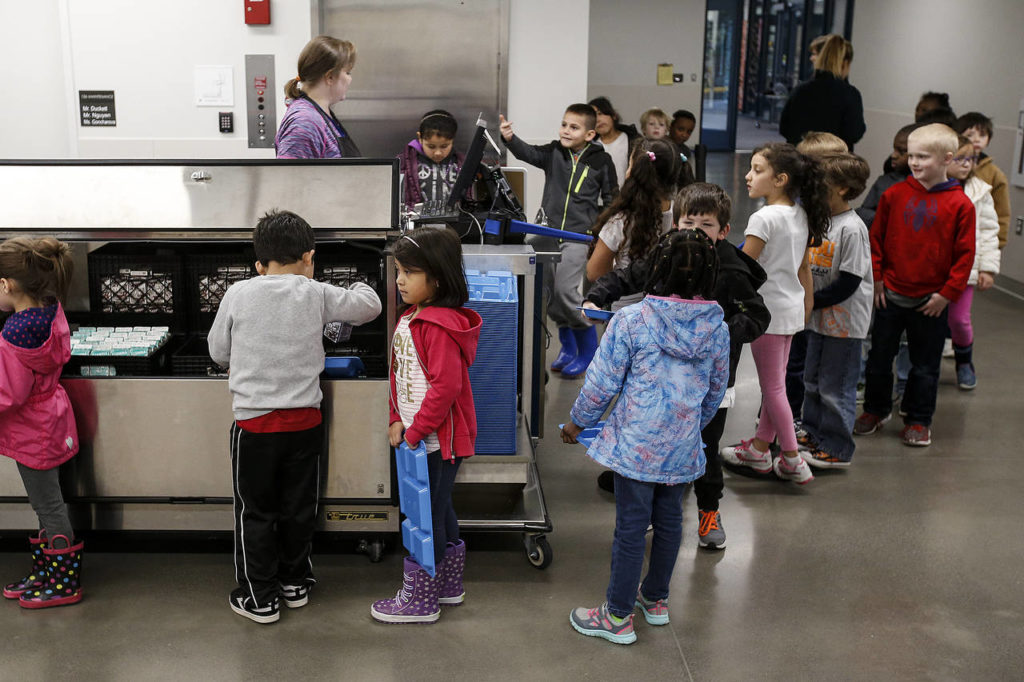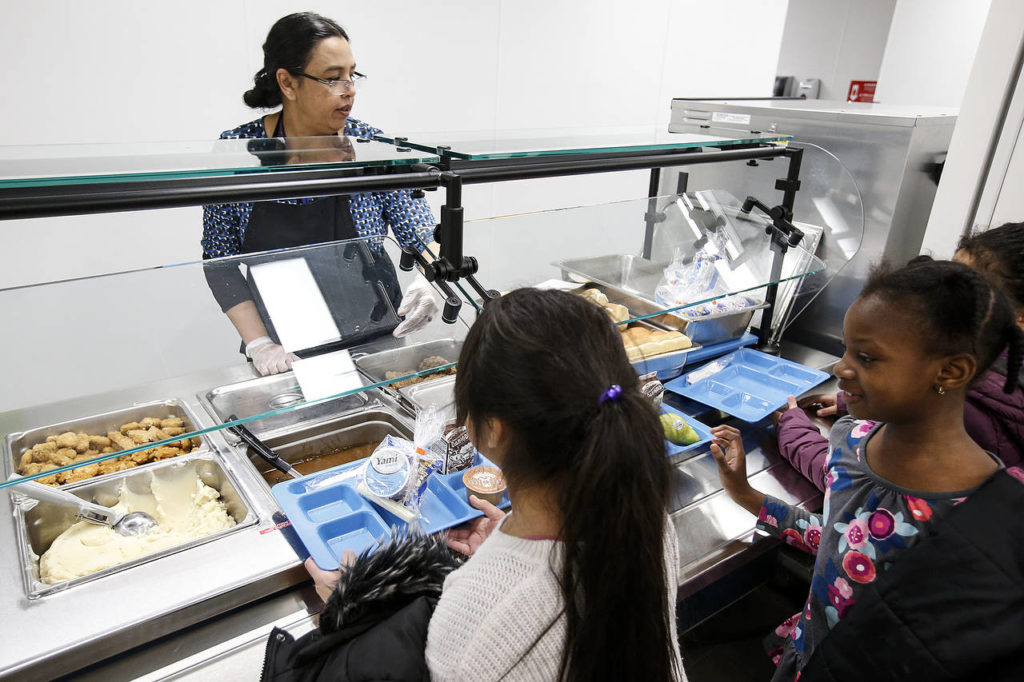EDMONDS — Many school districts have found themselves in a lunchroom food fight, an ethical quandary that pits financial responsibility versus student self-esteem.
A new policy in the Edmonds School District leans toward the latter, and student lunch debt is on the rise.
The unpaid tab now stands at nearly $28,000. By year’s end, it could balloon to more than $106,000, according to school district estimates.
The issue revolves around what to feed students who have fallen behind on payments.
In the past, rather than have them go hungry, Edmonds students were offered an alternative lunch, sometimes called a courtesy meal.
They were provided raisins, juice and a cheese sandwich on wheat bread. “We still wanted them to have something to eat,” said Barb Lloyd, the district’s director of food and nutrition services.
That practice, which is in place in most local districts, is intended to provide hungry kids some nourishment while keeping costs down.
But the policy has come under local and national scrutiny. Political leaders have pointed out instances of shaming children among their peers.
The U.S. Department of Agriculture allows schools to provide alternative lunches when there’s an unpaid tab for regular school lunches.
The federal agency advised schools to be careful not to do it in a way that would be embarrassing to the students in the lunch line.
In response, Edmonds launched a pilot program this school year to do away with courtesy meals.
Instead, all students, whether they pay full price, or qualify for free or reduced-cost lunches, and even those whose families have an outstanding bill for their meals, can go through the lunch line and get what they want.
“I think it’s a good and noble thing to have done,” Lloyd said. “It just comes with some side effects.”
Gone is the potential for shaming. But the school district with an enrollment of nearly 20,600 students is amassing an ever-growing IOU, mostly among those who don’t qualify for free or reduced-price lunches.
The debt has been increasing by about $3,500 a week.
“Clearly this isn’t sustainable unless someone identifies a source of funding to take care of it,” Lloyd said.
About 7,500 students buy their lunch each day, most of whom are in elementary school. The largest single lunch debt racked up this year is $172.50.
School districts are left trying to balance the debt-vs.-shame issue. “It’s really very difficult,” Lloyd said. “Those are both incredibly competing demands.”
In the past, the school district had a tight rein on lunch debt, occurring only in cases such as lunches being paid for with a bad check. The accumulated debt from 2010 until last spring was about $7,000, Lloyd said.
The public rallied with donations to wipe out that debt — and more. About $3,900 in donations remain.
The question is how to use it. One option is to use it to pay for lunches for families who have applied — but have not been approved — for free or reduced-price lunches, she said.
The debt for unpaid lunches by students who don’t qualify for free or reduced-priced meals is $24,500, Lloyd said.
The district included details of the school lunch debt issue in a recent edition of its electronic newsletter.
Families who aren’t up to date with lunch costs get email or voicemail reminders, and the school board is considering other steps.
The district wants to avoid the school lunch debts incurred nearly a decade ago. It entered the 2008 school year with more than $200,000 in unpaid meal debt. At the time, 2,750 students owed more than $10 each from the previous year. The trend led the district to tighten its policies. More families also applied for a government-subsidized lunch.
Applications for free or reduced-priced lunches can be made at any time during the school year. As one example of the income restrictions, a three-person household typically can make no more than $37,777 to qualify for a reduced, and in some cases, free meal.
Lunch debt is a national issue.
Three-quarters of school districts nationwide had unpaid student meal debt at the end of the 2016 school year, according to the School Nutrition Association, a nonprofit that represents school nutrition professionals around the country.
It can be a delicate issue: No one wants to see a child miss a meal or feel singled out for a parent’s mistake, but school districts can’t be saddled with tens of thousands of dollars in unpaid bills.
Closer to home, the situation differs from district to district.
In Granite Falls, one of the smaller districts in Snohomish County, there is no debt at the moment.
“The Granite Falls community is very supportive of its students,” said district spokeswoman Melanie Freeman. “The district has accounts set up at each school where people can donate funds to cover food costs.”
Last year, a couple in Marysville paid off the meal debt for 262 students from 10 schools.
Yet meal debt is part of the daily reality of running most schools. Last week, Marysville’s debt stood at $20,050 for students.
“We spent extensive time at our back-to-school meeting working with our food service staff regarding lunch shaming,” said Emily Wicks, a district spokeswoman. “Our practice is that at no time is a student to be spoken to about their balance or have a tray removed. Food service staff have been told for several years this is an adult issue with kid consequences.”
The district provides a courtesy meal, which consists of a turkey and cheese sandwich, unlimited salad and fruit and a milk. The sandwich is a menu offering each day.
The courtesy meal doesn’t kick in until students are five meals behind in payments.
“With the policy we have seen an increase in student debt,” Wicks said.
Also complicating the issue is the fact that federal guidelines changed for qualifying for free or reduced-price lunches, which has resulted in fewer families receiving the benefit, “therefore, increasing debt,” Wicks said.
Monroe now has a similar policy to Marysville with courtesy meals offered after five unpaid lunches.
The district last spring had a negative student meal balance of around $85,000 with $69,000 of that debt being owed by students with full-price meal status.
These days, the debt totals roughly $53,000. The debt has been steadily declining this school year.
“It continues to be our belief and practice that no child is ever denied a meal while at school,” said Erin Zacharda, a Monroe schools spokeswoman. “We have made some adjustments to our procedures, though, to help ensure that families are not continuing to accrue substantial meal debt.”
Those changes include increased communication when a student’s meal account is in the red through automated phone calls, emails and text messages. Quarterly letters are also sent out.
After five unpaid meals, students begin receiving the cheaper alternate meal, which includes a sandwich, fruit and milk.
A new policy in the Mukilteo School District may have helped trim the $84,000 lunch debt that piled up last year.
This year, the cashier has been moved to the front of the lunch line. The employee knows as soon as a student’s debit card is swiped whether the lunch fund is paid and up-to-date.
Elementary students who are not part of the free or reduced-price lunch plan with a debt of more than $15 are given a sack lunch of a cheese sandwich, fruit and milk, said school district spokesman Andy Muntz.
There’s no grace period for middle or high school students. “If you have a negative balance, you get the alternative lunch,” he said.
The lunch program’s debt now stands at $75,000, Muntz said.
The Snohomish School District is owed more than $76,000 for unpaid meals. Most of that debt was carried over from last year.
In July, it adopted a new school meal policy.
Like other districts, the policy states that “no student will ever be denied a complete and nutritious meal… regardless of the balance on the student’s account.”
At the same time, a student with lunch debt will not be allowed to charge a la carte items. A collection agency can be called if a student’s balance exceeds $50 or a family balance remains more than $100 for three months and a repayment plan has not been arranged.
In Snohomish, 152 students owe more than $100, according to the districts. The overall bill among that group is $37,661.
Other districts, such as Arlington, Darrington, Everett, Lake Stevens and Stanwood-Camano, report debt from a few hundred dollars to less than $5,000.
Talk to us
> Give us your news tips.
> Send us a letter to the editor.
> More Herald contact information.



























